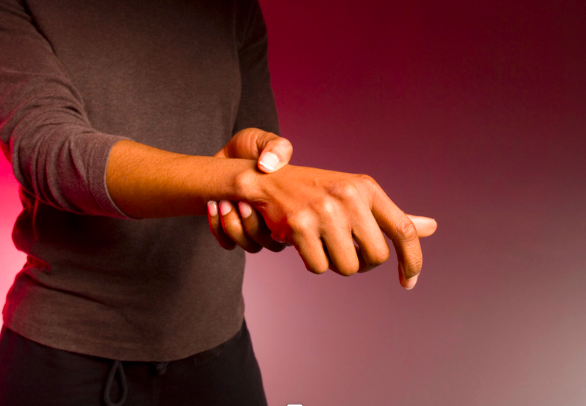Diagnosis and Treatment of Trigger Finger in Wake County

What is Trigger Finger?
Trigger finger, also known as stenosing tenosynovitis, occurs due to inflammation of the tendons that flex your fingers, causing finger tenderness and pain. The condition limits finger movement and can make it difficult to straighten or bend your finger. At Raleigh Orthopaedic, we offer care and treatment for a wide range of orthopedic conditions in Wake County, including trigger finger.

Causes of Trigger Finger
Your fingers have several small bones, which are connected to muscles by tendons. When your muscles contract or tighten, your tendons pull on your bones to move your fingers. Long tendons, called flexor tendons, extend from your forearm to the muscles and bones in your hands. Flexor tendons slide through a flexor tendon sheath, which is like a tunnel for the tendon. If the tunnel narrows, your tendon can’t move easily, which is what occurs in cases of trigger finger.
When the tendon slides through the narrowed sheath, it becomes irritated and swells. Motion becomes extremely difficult. Inflammation may cause a bump to develop, which further restricts movement. This results in your finger staying in a bent position and becoming extremely difficult to straighten.
Trigger Finger Risk Factors
Trigger finger tends to be more common in women than in men and usually occurs between the ages of 40 and 60. Based on a study completed by an academic medical institution, trigger finger is more prominent in musicians, farmers, and industrial workers. Other factors that increase a person’s chances of developing trigger finger include:
- Diabetes
- Hypothyroidism
- Rheumatoid arthritis
- Performing repetitive activities that can strain your hand, such as playing a musical instrument
Symptoms of Trigger Finger
If you don’t get treatment for it, trigger finger can progress. Advanced symptoms include the thumb, another finger (most commonly the ring finger), or both being locked in a bent or straight position. You may also be unable to uncurl your finger without using the other hand if you have an advanced case of trigger finger. The symptoms of trigger finger tend to be worse in the morning. The finger typically starts to relax and move more easily as the day goes on. Common early symptoms of trigger finger include:
- Lingering soreness in the base of your thumb or another finger
- A bump or lump around the base of your finger near the palm that can cause pain
- Tenderness around the base of your finger
- Clicking, snapping, or popping noise with movement
- Locking sensation when bending finger or stiffness in your finger
- Pain when you bend your finger
How is Trigger Finger Diagnosed?
A physician can usually diagnose trigger finger with an office visit, physical examination of your hand, and some simple questions about your medical history. Your doctor will listen to the characteristic click-upon movement of your fingers and look for signs of a bent finger. They may also watch you open and close your hand to assess your range of motion. Diagnosis of trigger finger will not usually require an X-ray or other imaging tests.

Treatment for Trigger Finger at Raleigh Orthopaedic
Treatment for trigger finger depends on the severity of the symptoms. Conservative treatment methods for this issue include:
- Rest: Take a break from repetitive activities for four to six weeks.
- Splinting: You may need to wear a brace or splint to restrict motion and rest the hand.
- Heat or ice: Heat or ice can be applied to reduce swelling. Placing your hand in warm water several times throughout the day can also relax the tendons and muscles in your fingers and hand.
- Exercise: Gentle exercises may help decrease stiffness and improve range of motion.
- Medications: Anti-inflammatory drugs (NSAIDs), can help relieve pain and inflammation and include ibuprofen (Advil), naproxen (Aleve), and other prescription anti-inflammatories.
- Steroid injections: Steroid injections may be given to resolve the issue. However, if symptoms do not improve after a second injection, surgery might be the next option.
If medications and at-home treatments do not work, your doctor may recommend a surgical procedure known as “tenolysis” or “trigger finger release.” Surgery for trigger finger is performed on an outpatient basis, with our surgeons operating out of our Raleigh Orthopaedic Surgery Centers. After an injection of local anesthesia to numb the area, your surgeon will make a small cut in the palm and then cut the tightened tendon sheath. As the tendon sheath heals, the area becomes looser, helping your finger move more easily. Surgery risks include infection or ineffective surgical results.

Recovery from Trigger Finger Surgery
Recovery from surgery for trigger finger can take a few weeks to six months. Your doctor may recommend physical therapy exercises to relieve post-surgery stiffness. You should be able to return to your normal activities within a few days after surgery. Your doctor will remove the sutures in 7 to 14 days. Before your procedure at Raleigh Orthopaedic, your team and your surgeon will ensure that all of your questions are answered and that the recovery process is clear.
How to Prevent Trigger Finger
In order to prevent trigger finger, you should try to avoid activities and actions that require an excessive amount of grip. If you cannot avoid such activities, be sure to take frequent breaks to protect against constant stress on the hands. If you play a sport that may cause trigger finger, learning the proper posture and techniques can help in preventing injury. Easing into exercises or workouts is also a great method for avoiding trigger finger and other orthopedic injuries. If you notice a small bump at the base of your finger, or feel a popping sensation when you move it, contact your healthcare provider.

Learn More About Hand and Wrist Treatment at Raleigh Orthopaedic
Our providers at Raleigh Orthopaedic want to help you live life more comfortably. We work with those of all ages facing all manner of orthopedic conditions and injuries in Wake County, including trigger finger. We provide personalized treatment options and always aim to avoid surgical intervention whenever possible. To learn more about what we do or to get started at Raleigh Orthopaedic, please give us a call or book an appointment online today!




